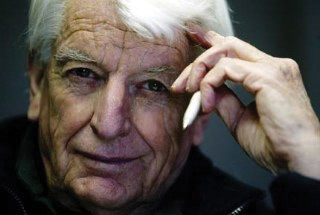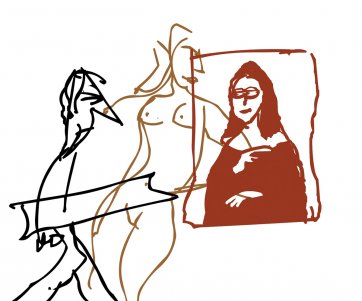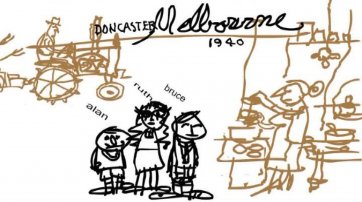Visitors to the collections display in the newly reopened National Portrait Gallery will see a number of recently commissioned portraits exhibited to the public for the first time. One of the most unusual of these new portraits is the animated self portrait by Bruce Petty.
Petty’s fame as a satirist and social commentator makes him a obvious choice as the subject for a commissioned portrait and his long association with animation suggests that an animated self portrait would match the Gallery’s ideal of representing each subject with the most telling means available. This would also be the first time that an animation has been commissioned by the Gallery.
Born in Doncaster on the outskirts of Melbourne in 1929, Bruce Petty is best known as one of Australia’s most successful and influential political cartoonists. His accomplishments are not confined to cartooning however, and include film, writing, sculpture, assemblage, printmaking and of course animation. Petty’s fascination with drawing led him to his first job in 1949 at Bill and Harry Owens’ Animation Studio at Box Hill where he worked on the animation Careful Koala, intended to help children get to school safely. His desire to learn more about art took him to London like so many culture-hungry Australians of his generation.
The young artist was enamoured by the wit and confident line he saw in the work of Ronald Searle, James Thurber and Feliks Topolski. Petty learnt that humour might be conveyed with the merest flick of the pen and that the nuance of line conveyed meaning more effectively than labouring the point with symbols or words. When he got work with an advertising agency he joked that he was only hired ‘because they thought he could do cheap Topolskis’. Despite his self effacing comments, Punch, The New Yorker and Esquire, perhaps the most prestigious journals to feature cartoons internationally, valued his work enough to publish his drawings on a number of occasions.
He returned to Australia in 1960 and regular work with the Bulletin producing the satirical drawings for which he is now known. Petty’s experience exploring South East Asia in 1962 at a time when political tensions were becoming increasingly visible also shaped his political awareness and this was echoed in the first published book of his drawings, An Australian Artist in South East Asia. Appointed chief cartoonist for the Australian in 1965, Petty was in an ideal position to point out the absurdity of the local and international politics, notably the imbroglio of the war in Vietnam to a national audience.
His distinctive cartoons express the complex character of the sixties and seventies: apparently simple line kinks into loops and whorls with the endearing complexity of knitting gone wrong, masking an intricacy and subtle humour with a wicked sting in the tail. A single dramatic squiggle of the pen was often enough to hold recognisable features and Petty endeared himself to a thinking public by creating a cast of twitching yet plausible players to echo the political shenanigans of real life and expose the machinations of government. Anthologies of his cartoons and drawings have been released at regular intervals to follow up his 1962 publication; these included The Money Book, The Petty Age, The Absurd Machine and most recently Petty’s Parallel Worlds, released this year.
Petty returned to moving image when he teamed with journalist and film producer Phillip Adams to make his first film, Hearts and Minds in 1970 and then went on to create, in 1972, his first animated film, Australian History. In 1976 he wrote and directed Leisure, a humorous examination of the importance of leisure in a work-drive society. It won an Oscar. ‘The Oscar was a great surprise’ said Petty, who noted that ‘Prizes for art are odd, but nice when they happen.’
Petty continued with his interest in film making, maintaining a regular output: Marx (1981), Money (1998), This Mad Century (1999) and Human Contraptions (2002). His most recent film Global Haywire 2007 is a feature length film that combines animation and documentary film. Petty’s Self portrait is entirely animated in Flash. The software allows one person to make an animated film with out the high overheads of the typical animation studio.
By definition, Petty’s animated self portrait is not a static image. Petty’s inimitable drawings described a life’s journey, compressed into a few minutes. The Careful Koala makes a brief appearance, as does highlights from the artist’ life: on the grand tour in Europe confronting the masterpieces of art history; as a world traveller, half man half aircraft; witnessing destruction in South East Asia; and eventually framed and hung in the National Portrait Gallery. Petty admits the journey ‘finished up being a professional history rather than a personal history’ and suggests this is an inevitable result of the need to sum up a lifetime lived into a few minutes. All his children, Sam, Tom and Alice, make an appearance tap dancing: ‘They are a big factor (in my life) and had to be there somehow.’
















